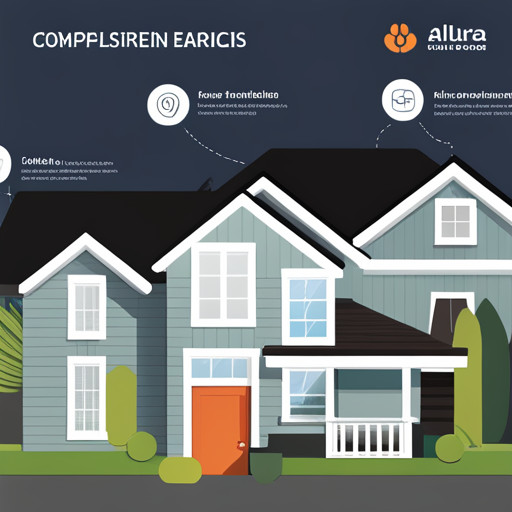Allura Fiber Cement Siding Settlement Compensation Options for Homeowners
This article examines the settlement reached regarding Allura Fiber Cement Siding, specifically manufactured between February 2014 and 2015.

It explores the allegations raised against the siding's defects, the compensation options available to homeowners, and the denials issued by the manufacturing company.
Additionally, the article highlights the process of determining eligibility for compensation, the required documentation for filing claims, and the critical dates associated with the settlement.
Key Takeaways
- Class members can choose from three compensation options: replacement and repair, quick cash option, or cash option with proof of repair.
- The settlement covers claims for qualifying damage and alleged property damage resulting from failed Allura fiber cement siding.
- Claimants must provide proof of purchase and specific documentation for each type of claim.
- The deadline to submit a claim form is 06/21/2023, and the claims administrator will pay the approved amount within 30 days.
Understanding the Allura Fiber Cement Siding Settlement

The Allura Fiber Cement Siding Settlement, which covers claims for qualifying damage and alleged property damage resulting from failed siding, offers three compensation options to homeowners: replacement and repair, quick cash option, or cash option with proof of repair.
The impact on the housing market is significant, influencing not only the value of individual properties but also the broader real estate sector. Homeowners, potential buyers, and real estate professionals must factor in the potential long-term effects of siding damage when evaluating property values and considering renovation costs.
This settlement, therefore, has implications for the broader housing market, affecting decisions about property investment, maintenance strategies, and future housing market trends. The long-term effects of siding damage may include structural instability, decreased property value, and increased maintenance costs.
Who Is Included in the Class

Inclusion in the class is limited to those possessing residential properties adorned with specific manufacturing plant-produced exterior cladding during the outlined periods.
Two manufacturing plants, notably Plycem's White City, Oregon plant and the Roaring River, North Carolina plant, are implicated in the disputed claims concerning Allura fiber cement siding.
The eligibility period for the Oregon plant spans from February 1, 2014, to May 7, 2014, while that of the North Carolina plant extends from February 1, 2014, to February 18, 2015.
Class membership requires proof of property ownership and specific documentation for each claim type.
The settlement website offers accessibility to the necessary claim form, which must be submitted by the deadline of June 21, 2023.
Allegations Against Allura Fiber Cement Siding

Allegations emerged suggesting that products manufactured during specific periods at Plycem's plants in White City, Oregon and Roaring River, North Carolina, exhibited defects such as cracking, bowing, shrinking, and breaking. This led to a class-action lawsuit where homeowners demanded compensation for the alleged defects.
Despite denying the existence of any defects, Plycem opted for an allegations settlement to avoid a protracted legal battle. A comprehensive compensation options analysis was conducted to ensure fairness in the compensation process. Three options were identified, replacement and repair, quick cash, and cash with proof of repair.
The settlement aims to compensate homeowners for the alleged property damage resulting from the purportedly defective siding. The claim deadline was stipulated as June 21, 2023.
Denials From Allura Fiber Cement Siding

Despite the litany of accusations leveled against them, defendants maintained that the construction materials they produced were devoid of any defects, yet agreed to a resolution to circumvent a potentially lengthy legal battle.
In the context of the Allura Fiber Cement Siding Lawsuit Allegations, the defendants vehemently rejected the claims that the siding was defective. Within the framework of the Allura Fiber Cement Siding Denials, the defendants stated the issues raised were not reflective of the overall quality of their product.
However, recognizing the adverse effects of a protracted legal process, a settlement was reached. This decision, they contended, was not an admission of guilt but a strategic move to avoid further litigation and to maintain focus on their commitment to producing quality construction materials.
The Role of Allura in Home Construction

Contributions of this entity to the field of building construction encompass a range of materials, extending beyond siding to include panels, trim, and soffit.
The role of Allura in the siding industry is significant, with a reputation for product quality and durability. However, allegations of product failure have called into question Allura's credibility in the industry.
Despite these allegations, Allura's product range remains popular among professionals in the construction industry due to its versatility and aesthetic appeal. Allura's fiber cement siding, in particular, is recognized for its ability to effectively resist damage from harsh weather conditions.
Nonetheless, the recent legal proceedings have underscored the importance of rigorous quality control practices in maintaining Allura's reputation in the building construction industry.
Details on the Settlement Coverage

Details on the resolution include specific criteria for claim eligibility, varying potential awards, and distinct choices for remuneration.
The potential settlement amounts vary, depending on the compensation option chosen by class members.
The process for filing a claim necessitates proof of purchase and the submission of a claim form via the settlement website.
1. Eligibility: Homeowners possessing Allura fiber cement siding from specific manufacturing plants are eligible.
2. Potential Settlement Amounts: Awards are variable, hinging on the compensation option selected.
3. Compensation Options: Options include replacement and repair, quick cash option, or cash option with proof of repair.
4. Claim Filing Process: Claimants must provide proof of purchase and submit a claim form through the settlement website. The deadline to submit is 06/21/2023.
Exploring the Compensation Options

Exploration of the various remuneration choices reveals three distinct avenues for claimants: replacement and repair of the product, a quick cash payout, or a cash payout following proof of repair.
When exploring the compensation process, it is crucial to understand the specifics of each option.
The replacement and repair avenue encapsulates the cost of primed fiber cement boards, additional repair costs, and a paint allowance.
The quick cash option provides compensation for qualifying damage.
Meanwhile, the cash option with proof of repair is available if the qualifying damage does not exceed 30% of an elevation.
Evaluating the settlement options, claimants may receive additional compensation for remaining portions of the elevation with sufficient proof of repair.
The approved amount is paid within 30 days by the claims administrator.
Replacement and Repair: What’s Covered

The exploration of compensation options brings to light the specifics of the replacement and repair coverage, a significant aspect of the Allura Fiber Cement Siding Settlement. The focus now shifts to understanding this coverage and the proof of purchase requirement.
1. The replacement and repair coverage caters to the cost of primed fiber cement boards, additional repair expenditures, and a paint allowance.
2. A claimant must present a proof of purchase to validate their claim.
3. The coverage extends to situations where the siding has manifested defects such as cracking, breaking, bowing, or shrinking.
4. The claimants are assured of receiving 100% of the approved amount within 30 days after their claim is validated, thus providing a swift resolution to their predicaments.
Quick Cash Option Explained

Quick cash option, another alternative available to claimants, provides recompense for qualifying damage. This option is considered beneficial as it simplifies the process of claiming compensation. As part of the quick cash option benefits, claimants are not required to provide proof of repair, making it a less stringent alternative compensation option.
The claimants are granted a fixed amount per square foot of damaged siding, offering an immediate resolution to the claim. However, this option is limited to homes with damage not exceeding 30% of an elevation. It is critical for the homeowners to understand the constraints and benefits of this option.
Careful consideration of all alternative compensation options, including the quick cash option, ensures that claimants are able to make informed decisions regarding their claim.
The Cash Option With Proof of Repair

Cash option with proof of repair is a distinct alternative available to claimants whose qualifying damage does not exceed 30% of an elevation. This option is unique because it provides an opportunity to receive compensation without undergoing the replacement or repair process. This reduces the time, resources, and inconvenience associated with traditional claim processes.
The claimant must provide sufficient proof of repair to be eligible for this option. The cash option requirements stipulate that the amount of damage should not exceed 30% of an elevation. The claim must be filled properly and submitted before the deadline. The cash option with proof of repair can be availed only by homeowners who adhere to the filing a claim process as specified by the settlement.
How to Determine Eligibility

Shifting focus from the cash option with proof of repair, attention now turns to the process of determining eligibility. It is vital for potential claimants to understand the eligibility requirements, as these stipulations are the foundation for any claim.
A claimant must meet specific criteria, which include being a homeowner with Allura fiber cement siding from certain manufacturing plants within a specified timeframe. Additionally, proof of ownership is a prerequisite.
Once the eligibility requirements are met, the process of filing a claim can commence. This involves filling out a claim form available on the settlement website, providing the necessary documentation, and adhering to the deadline for submissions, which is set at 06/21/2023.
Required Documentation for Claims

Documentation requirements for filing a claim involve providing tangible proof of ownership and evidence of the alleged damage, as per the stipulations set in the settlement agreement. These requirements form a critical component of the claims process in the Allura Fiber Cement Siding Settlement.
The required documentation includes:
1. Proof of ownership: This can include a deed, mortgage statement, or tax bill that verifies the claimant as the property owner during the relevant period.
2. Photos: Clear images that capture the alleged damage to the siding are required.
3. Repair receipts: If repairs were undertaken, claimants must provide receipts to substantiate the repair costs.
4. A completed claim form: This must be filled out accurately and submitted by the claim deadline, 06/21/2023.
This documentation serves to validate the claim and facilitate the compensation process.
Important Dates and Additional Information

Key timelines in the claims process include the final approval hearing which took place on May 17, 2021, and the impending claim submission deadline of June 21, 2023. These important deadlines serve as a guide for claimants to ensure timely submission and processing of claims.
The settlement website, PlycemSidingSettlement.com, provides necessary information and resources, including a claim form for class members. It is imperative to note that the opportunity to opt out or be excluded from the settlement has passed.
The claims administrator stands ready to assist with any inquiries. It is essential for potential claimants to only file a claim if eligible, in adherence to the integrity of the process and to avoid fraudulent claims.
Frequently Asked Questions
What Is the Process for Selecting the Right Compensation Option for My Specific Situation?
The process for selecting the appropriate compensation option requires a careful review of Settlement Eligibility criteria and Compensation Calculations.
It involves evaluating the extent of damage, estimating repair costs, and considering the available options: replacement and repair, quick cash, or cash with proof of repair.
Additionally, it necessitates submitting a claim form with appropriate documentation before the deadline.
The final decision should align with the individual homeowner's circumstances and the specific conditions of their siding.
How Can I Get Assistance in Filling Out the Claim Form or Understanding the Required Documentation?
Claim assistance and understanding documentation requirements are crucial in claim form completion. Assistance can be obtained from the claims administrator, who provides guidance on the process.
The claim form available on the settlement website outlines the required documentation. This includes proof of ownership and evidence of qualifying damage.
Thorough understanding of these requirements can promote accurate form completion, thereby facilitating eligibility determination.
What Are the Potential Tax Implications of Receiving This Settlement?
Potential tax implications of receiving a settlement vary depending on the nature and classification of the funds.
In general, compensation from a lawsuit settlement may be classified as income, which could increase tax liability. However, certain types of compensatory damages may be exempt from taxation.
It is advisable to consult with a tax professional to understand the specific tax implications and potential settlement impact.
What Are the Consequences of Not Submitting a Claim by the Deadline?
Failure to make a claim submission by the stipulated deadline could result in forfeiture of the right to compensation. This is a common consequence in legal settlements.
The deadline impact is significant as it denotes the closure of the opportunity to receive redress for the alleged damage. Therefore, it is essential for claimants to adhere to the timeline set forth in the settlement agreement to ensure they are not excluded from potential compensation.
If I Am Not Satisfied With the Settlement, Is There a Way to Appeal the Decision?
In the realm of legal disputes, dissatisfaction with a settlement decision may lead to an appeal process. This typically necessitates acquiring legal representation to assist in navigating the complexities of settlement negotiation and appeal proceedings.
However, the ability to appeal a settlement decision greatly depends on the terms of the agreement and the laws governing the particular jurisdiction. Legal counsel can provide valuable insight into the potential success and feasibility of an appeal.

This post has been generated by AI and was not reviewed by editors. This is Not legal advice. Please consult with an attorney.




